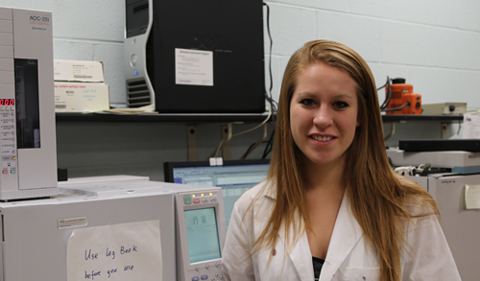Mary Bouschard ’16 walked into the Dayton offices of the Miami Valley Regional Crime Lab knowing she’d be the only toxicology intern. But she was following in the footsteps of another Bobcat, Jenna Silverman ’14.
“They only took one intern in the toxicology section, and then they took two interns in their DNA section, which was like a second half of the lab. I was the only one in the toxicology lab. It was a little nerve-wracking,” says Bouschard. But she was well-prepared for the work.
“For forensics, you can’t really start looking for an internship until your junior or senior year, just because you have to have the skillset behind you or they won’t take you. So you usually start your junior year and apply for a summer position,” says Bouschard, a senior majoring in Forensic Chemistry at Ohio University.
“I found out about it (the Miami Valley Regional Crime Lab) because Jenna Silverman, who was in the grade before me, had gotten the internship, and she told me about it and said, ‘Here, apply.’”
“And now she works for them,” adds Bouschard.
Silverman is part of the Montgomery County Coroner’s Office Toxicology Laboratory, a regional laboratory that provides postmortem forensic toxicology services to 40 Ohio counties. The Toxicology Lab also provides human performance forensic toxicology services to approximately 100 police agencies in and around the Miami Valley as part of the Miami Valley Regional Crime Lab. Silverman is one of five full-time forensic toxicologists at the lab, all licensed by the Ohio Department of Health, Bureau of Alcohol and Drug Testing.
Doing Her Own Research Project at the Crime Lab
Bouschard says her favorite part the summer 2015 internship was getting to do her own research project, which is a key component of the lab’s Forensic Science Internship. ” I was working in their tox section and got to really enjoy using the instrumentation.
“I worked a lot with their GC-MS, and I made a method for their glycols—for determining glycols in biological fluids and samples,” she adds. A glycol is an organic compound in the alcohol family.
Gas chromatography–mass spectrometry (GC-MS) combines gas-chromatography with mass spectrometry and is often used in crime forensic analysis to test for specific substances, such as drugs of abuse, explosives or trace elements.
Forensic Chemistry—Choosing Between Toxicology & DNA
“There’s two tracks you can take here at Ohio University’s chemistry program,” Bouschard says. “There’s DNA and then toxicology. And I always had a fascination with drugs and the brain and how they worked with the body.” That put her on the toxicology track.
What Bouschard found in the lab was familiar because of her coursework at OHIO, especially her courses with Dr. Jules Guei.
“I guess he just taught a lot about the actual drug interaction with the body. So when they we use terminology around me, I was able to follow through and understand why they use certain chemicals for things,” including the metabolism of various drugs and how what machines and instruments to use for the different types of analysis.




















2 Comments